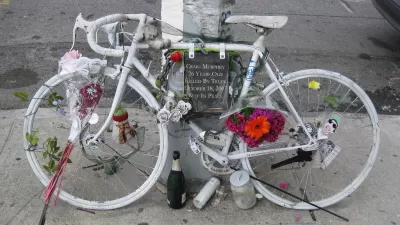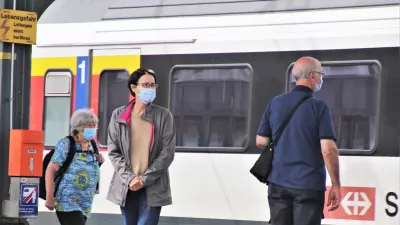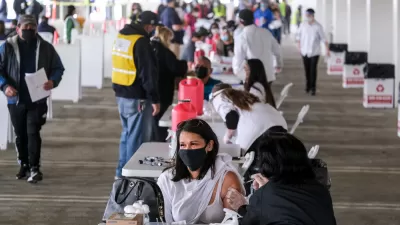There's good and bad news to report from the 37-year study. Good news: Decreased child fatal bike crashes, but it results from fewer children biking. Bad news: Increased adult fatal crashes, but it results from an increase in adult male cyclists.

"This report examines mortality trends among cyclists using national collision data from the Fatality Analysis Reporting System (FARS) for the period 1975–2012," as published in the U.S. Centers for Disease Control and Prevention's Morbidity and Mortality Weekly Report (MMWR).
"The researchers pointed out that the profile of the typical bike rider has changed a lot during that time, with fewer kids riding a bicycle every day and more adults -- especially men -- doing so," writes E.J. Mundel for HealthDay News.
Recent years have seen the largest increase in bicycling [among adults]," the authors wrote. "For instance, during 2000-2012, the number of U.S. workers who traveled to work by bicycle increased 61 percent," they said.
Most of that growth occurred among men aged 25 to 64. In the meantime, "cycling rates have remained steady for women and have fallen among children," [the researchers] said.
Aside from the growth among adult male cyclists, decrease among children cyclists, and no-change in female adult cyclists, here were some factoids from the report:
- On a per-trip basis, bicyclists die on U.S. roads at a rate double that of vehicle occupants
- Bicycles account for only about 1% of trips across all modes of transportation
- Report has a table showing the "average annual age-adjusted cyclist mortality rates, by state (except for Alaska and Hawaii) for 1975–1979 and 2008–2012"
The study, led by Dr. Jason Vargo, an assistant scientist with the Global Health Institute and the Nelson Institute for Environmental Studies of the University of Wisconsin-Madison, "points to the need for 'expanding traditional road safety interventions' -- which have typically focused on motor vehicles -- to focus on the safety of bicyclists, as well, the report's authors said," concludes Mundel.
So how can biking be made safer for all Americans? The report's authors said tried-and-true methods have already been successful in bringing overall death rates down. These include improvements in "road design and engineering, traffic law enforcement, driver and bicyclist behavior, helmet use, and traffic volume," they wrote.
The research team noted that many "bike-friendly" U.S. cities have already launched successful interventions, initiatives such as: dedicated bike lanes that are physically separated from car traffic; lowered speed limits; more speed bumps; and better education on safer bike/motorist behaviors.
Hopefully local transportation departments and transportation policy leaders will utilize the findings of this CDC report to make roads safer for cycling so as to decrease crashes and just as importantly, increase cycling among children and women.
Hat tip to AASHTO Daily Transportation Update
FULL STORY: U.S. Bike Deaths Fall for Kids, But Rise for Adults

Americans May Be Stuck — But Why?
Americans are moving a lot less than they once did, and that is a problem. While Yoni Applebaum, in his highly-publicized article Stuck, gets the reasons badly wrong, it's still important to ask: why are we moving so much less than before?

Using Old Oil and Gas Wells for Green Energy Storage
Penn State researchers have found that repurposing abandoned oil and gas wells for geothermal-assisted compressed-air energy storage can boost efficiency, reduce environmental risks, and support clean energy and job transitions.

Placekeeping: Setting a New Precedent for City Planners
How a preservation-based approach to redevelopment and urban design can prevent displacement and honor legacy communities.

Colorado Lawmakers Move to Protect BRT Funding
In the face of potential federal funding cuts, CDOT leaders reasserted their commitment to planned bus rapid transit projects.

Safe Streets Funding in Jeopardy
The Trump administration is specifically targeting bike infrastructure and other road safety projects in its funding cuts.

Six Reasons Why Housing Is a Human Right
Is housing a human right? A law professor shares six reasons why it should be, from its role in protecting other rights to global recognition and U.S. legal traditions. As public support grows, could housing be the next right written into law?
Urban Design for Planners 1: Software Tools
This six-course series explores essential urban design concepts using open source software and equips planners with the tools they need to participate fully in the urban design process.
Planning for Universal Design
Learn the tools for implementing Universal Design in planning regulations.
Heyer Gruel & Associates PA
City of Moreno Valley
Institute for Housing and Urban Development Studies (IHS)
City of Grandview
Harvard GSD Executive Education
Salt Lake City
NYU Wagner Graduate School of Public Service
City of Cambridge, Maryland





























